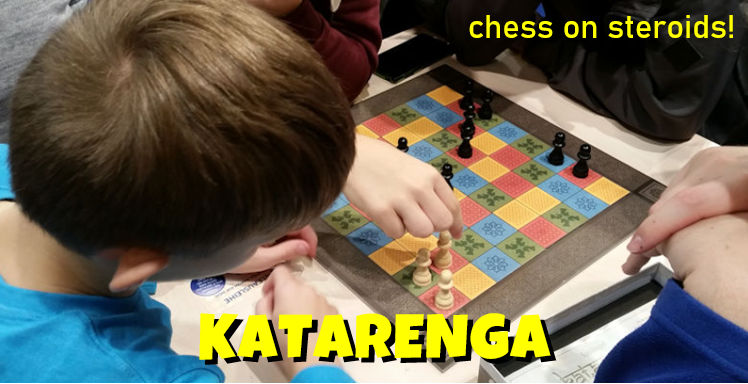Katarenga
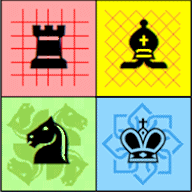 is played on a colourful chessboard by two players designated Black and White, each with eight pawns of
their own colour. It's not strictly a chess variant, but pawns do move like chess pieces, except that their move is
determined by the colour of the square they start from. Specifically, a pawn on a red square moves like a
rook, one on a yellow square moves like a bishop, one on a green
square moves like a knight, and one on a blue square moves like a king.
Thus, as Shakespeare might have said, "One pawn in its time plays many parts".
is played on a colourful chessboard by two players designated Black and White, each with eight pawns of
their own colour. It's not strictly a chess variant, but pawns do move like chess pieces, except that their move is
determined by the colour of the square they start from. Specifically, a pawn on a red square moves like a
rook, one on a yellow square moves like a bishop, one on a green
square moves like a knight, and one on a blue square moves like a king.
Thus, as Shakespeare might have said, "One pawn in its time plays many parts".
The basic game is described below - you can see demos of it online in English or German. But the same equipment and rules of movement lend themselves to a variety of other games, as listed in the links above. You are even invited to invent variations of your own.
Published by Huch Spiele, Katarenga is distributed in UK by Asmodee and in France by Atalia.
The Katarenga board has 16 squares in each of four different colours.
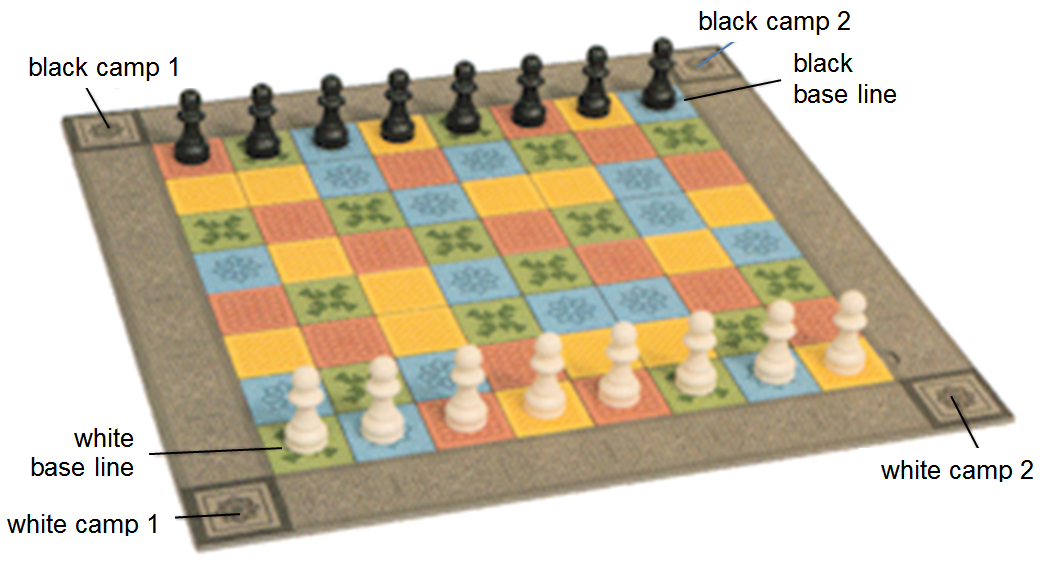
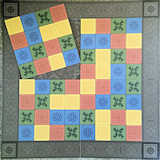
For each game a new board (left) is constructed from four double-sided asymmetrical quarterboards that can be randomly arranged to form thousands of different whole boards.
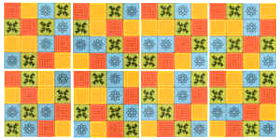
These are the eight quarterboards.
The four in the lower row are
the reverse sides of the ones
directly above them.
How pawns move and capture
A pawn's move is dictated by the colour of the square it starts from:
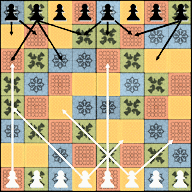
From red, it moves like a rook (any distance but
not beyond the next
red square in line).
From yellow, it moves like a bishop (any distance
but not beyond the next yellow square
in line).
From green, it moves like a knight.
From blue, it moves like a king.
It captures by landing on an enemy piece and removing it from the board (as at Chess).
Object of the game
In the basic game,

Enemy camp
you aim to get any two of your pawns across the board from your baseline (the row nearest you) to your opponent's
baseline (opposite). Once you get a pawn to the opposite side you then in a subsequent turn move it over the edge and post it
on one of the two decorated squares in the corner - provided that it is not captured first.
(The corners are called "enemy camps" in the published rules, which offer a picturesque background story about two opposing armies in the Persian Empire around 3000BCE trying to send two spies across to the enemy camp. The title Katarenga vaguely suggests Chaturanga, the Indian ancestor of Chess, or Chatrang, its Persian equivalent.)
Set-up
You each in turn take any quarterboard and place it more or less at random in the board frame. Each can go either way up and any way round, so producing a different overall pattern for each game or session. It's advisable, but not mandatory, to avoid getting two reds at the opposite ends of the same row or column or two yellows at diagonally opposite corners. Agree who will play White and who Black. Black examines the board, chooses which of the four possible baselines to start from, rotates the board so as to position it immediately in front of them, and sets up the eight black pawns along it. White does likewise on the opposite side, and makes the first move.
Play
You each in turn move any one of your pawns in accordance with the rules of movement and capture as described above, but note that on your first move you may not capture an opposing pawn from its home rank. (Why not?)
When you land a pawn on the opposite baseline it is still vulnerable to capture. So long as it remains uncaptured you can use a later turn to carry it to safety over the edge of the board, though you may, if you wish, move it back into the playing area. Once taken off the board it is placed in one of the two enemy camps at opposite corners.
The game ends as soon as one player wins either by getting a second pawn home and onto the other enemy camp, or by capturing seven or all eight opposing pawns - or, of course, when one player resigns. You may consider it a double win if you get two home before your opponent has got one.
Match play
In order to ensure that the first player didn't win because of a more favourable initial board configuration, you should then turn the whole board through 180 degrees and play again with the Black having the first move, so playing from exactly the same position as White did in the first game. In subsequent games you may like to give the board a quarter-turn to produce a new pair of starting positions.
Notes
How many possible configurations? The first quarterboard may be placed either way up in and any of four different orientations, giving eight possible patterns for the first quarter. The same applies to each of the others, making 8^4 or 4096 patterns in all. But then each one of the four may be placed in any of six different positions relative to the other three - viz. ABCD, ABDC, ACBD, ACDB, ADBC, ADCB circularly from any given corner. Then 6 x 4096 = 24,576. The fact that the whole board may be placed with either pair of opposite sides as baselines doubles the number of opening arrays to 49,152. (Return)
Why not capture on the first move?
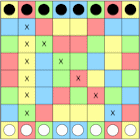 Because some configurations (red squares at opposite ends of the same
column, or two diagonally opposite yellows, as illustrated)
would otherwise permit a homing capture on the first move. This would be at
best inelegant and at worst unfair.
Prohibiting initial capture seems neater than forbidding such
configurations. (Return)
Because some configurations (red squares at opposite ends of the same
column, or two diagonally opposite yellows, as illustrated)
would otherwise permit a homing capture on the first move. This would be at
best inelegant and at worst unfair.
Prohibiting initial capture seems neater than forbidding such
configurations. (Return)
